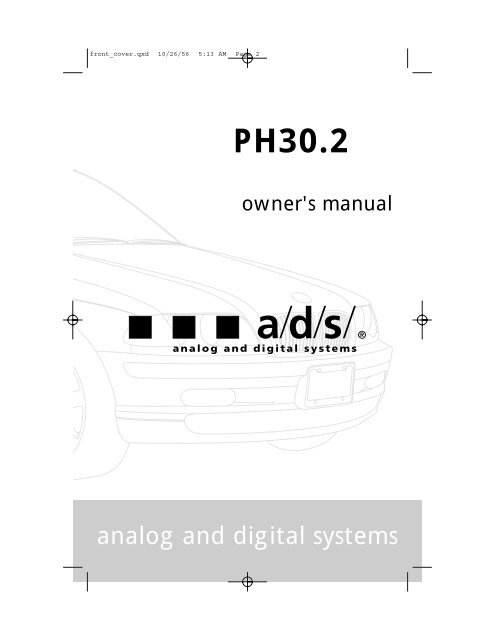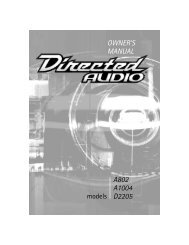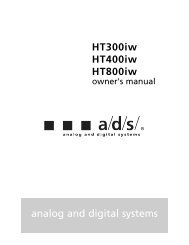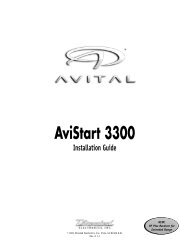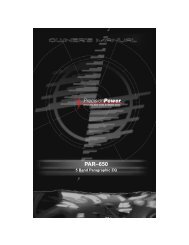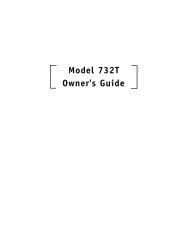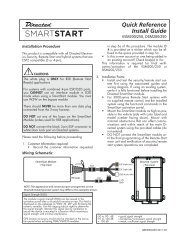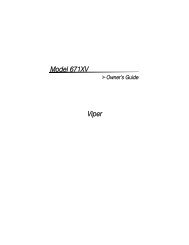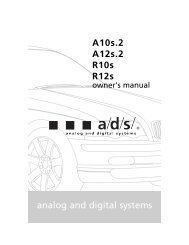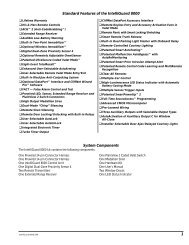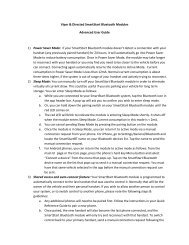PH30.2 - Directed Electronics, Inc.
PH30.2 - Directed Electronics, Inc.
PH30.2 - Directed Electronics, Inc.
You also want an ePaper? Increase the reach of your titles
YUMPU automatically turns print PDFs into web optimized ePapers that Google loves.
front_cover.qxd 10/26/56 5:13 AM Page 2<br />
<strong>PH30.2</strong><br />
owner's manual<br />
analog and digital systems
table of contents<br />
introduction 1<br />
about this manual 2<br />
features of your PowerPlate 2<br />
warning and tips 3<br />
mounting locations 3<br />
system planning 4<br />
system configurations 5-9<br />
amplifier and crossover controls 10-11<br />
installation 12<br />
controls and connections 12-13<br />
signal sources 14<br />
internal signal routing 15<br />
multi-cross crossover and configurations 16<br />
constant bass control 17<br />
AC502 operation 17<br />
tuning 17-18<br />
troubleshooting 19-20<br />
specifications 21<br />
warranty information 22<br />
introduction<br />
Although it may be hard to remember, back in the 1970’s, car audio as we now know it didn’t really exist.<br />
Sure, music lovers could buy a cassette or 8-track tape deck and some 6" x 9" three-way speakers.<br />
Advanced stereo buffs might even add a "power-booster" to increase output too as much as 12 watts<br />
RMS! But none of this really delivered the power to cut through road noise with sound quality that<br />
compared with the best home audio. Not until 1979 that is, when a/d/s/ introduced the revolutionary<br />
PowerPlate P100 amplifier and 300i 2-way plate loudspeakers. Aesthetically, the P100 introduced the<br />
low profile design which has been an a/d/s/ trademark to this day. Technologically, the P100 combined a<br />
high efficiency switching power supply with a state-of-the-art, discrete high-current stereo power<br />
amplifier. For the first time, a car audio system existed with the musical integrity and dynamic range that<br />
made you want to take long drives to nowhere, just to listen to the music. High quality car audio was<br />
born, and the original a/d/s/ PowerPlate P100 made it happen.<br />
The latest improvements to the PowerPlate line-up include increased heatsink area to facilitate higher<br />
power output, Constant Bass circuit for subwoofer signal that can be mixed into all channels, and fully<br />
balanced high-level inputs compatible with any source. The amplifier you have purchased is an<br />
enhancement of the respected P-series multichannel amplifiers. In this version, we have improved upon<br />
the already acclaimed sound quality by addressing internal details, and upgrading selected components<br />
to incorporate the latest technology which was not available when the P-series was originally designed.<br />
Selected low-noise, high-speed Burr-Brown® op amps are used in critical circuits. Class-A biasing is used<br />
throughout the voltage-gain and active crossover stages. Numerous modifications and "tweaks" were<br />
also performed which improve the power supply dynamics and reduce noise. These changes improve<br />
transparency and dynamic linearity, resulting in a smoother and more detailed top-end, tighter bass, more<br />
explosive dynamic contrasts, and virtually holographic imaging. Left intact are the P-series unequalled<br />
flexibility, high efficiency and superb reliability. These, along with multichannel design, are fundamental in<br />
the a/d/s/ approach to systems engineering, which makes achieving true high fidelity reproduction simple<br />
and predictable in any installation.<br />
1
about this manual<br />
To get the most from your a/d/s/ PowerPlate, we recommend that you have the installation performed<br />
by your qualified authorized a/d/s/ dealer. If this unit is installed by your dealer, we will extend the warranty<br />
to two years instead of the standard one-year. However, if you feel that you have the necessary skills and<br />
prefer to perform the installation yourself, this manual will guide you through the process of installation<br />
and set-up. Please read through it completely before beginning the installation so that you may familiarize<br />
yourself with the total procedure before you begin. If there is anything that you do not fully understand,<br />
please consult with your a/d/s/ dealer before attempting the installation.<br />
keep listening, but be safe!<br />
Sustained listening to loud music over 100dB has been shown to cause permanent hearing damage.<br />
Systems using a/d/s/ components are capable of achieving volume levels, which substantially exceed this<br />
level. When operating your system for sustained periods at high volume, be sure to use hearing protection<br />
to prevent long-term exposure. We want you to be able to enjoy the music for many more years.<br />
features of your PowerPlate<br />
Transient Perfect MOSFET Power Supply - The heart of the P-series, this supply frees the<br />
PowerPlate from the constraints of common pwm (pulse width modulated) supplies. The advantages<br />
are: extremely fast overload recovery time, low output impedance for superior damping, and stability<br />
during voltage fluctuations for reliable performance in the harsh automotive environment.<br />
Remote Subwoofer or Constant Bass Level Control Capability - Can be used with accessory control<br />
AC502 to provide a dashboard mounted rear channel subwoofer or Constant Bass level control.<br />
Digital Crossover Frequency Display - The crossover frequency for each channel pair is displayed on<br />
the top of the amplifier for quicker, more precise system tuning.<br />
Detachable Plug in Connectors - High current speaker and power connectors simplifies installation.<br />
Multi-cross Variable Built-in Crossovers - High-pass, Low-pass and Bandpass functions are built-in,<br />
virtually eliminating the need for external crossover networks in even the most elaborate systems.<br />
Constant Bass circuit - Signal from all input channels is summed, low-pass filtered and then made<br />
available to all channels.<br />
PowerPlate Design - a/d/s/ original low profile, high efficiency heatsink design keeps size minimum<br />
and allows mounting where space is limited.<br />
Wide Input Sensitivity Range - Allows connection to virtually any source unit from factory OEM radios<br />
through low output preamps.<br />
Simultaneous Stereo and Mono - Each channel pair may be used Stereo, Mono, Bridged or both Stereo<br />
and Mono simultaneously. This allows an additional Mono speaker to be used with a stereo pair for<br />
center-channel or subwoofer applications from each channel pair.<br />
Same Side Adjustments - The P-series PowerPlate makes system adjustment easy by organizing all<br />
signal-processing controls on one side of the amplifier. This layout allows convenient system adjustment<br />
and facilitates a variety of installation possibilities when access to the controls is desired.<br />
2
warnings and tips<br />
Always disconnect the battery ground wire before doing any work on your vehicle. Reconnect the cable<br />
only after the installation is complete and the wiring has been checked to make sure that there are no<br />
problems. If your radio features a code type security system, be sure you know the code before<br />
disconnecting the battery!<br />
Your a/d/s/ PowerPlate should be installed in 12V negative ground vehicles only. Connection to other<br />
types of electrical systems may cause damage to the vehicle or the amplifier. Wear Eye and Ear protection<br />
when using power tools.<br />
Before cutting or drilling carefully inspect the area to make sure there are no electrical wiring, fuel lines<br />
or brake lines that could be damaged. Sometimes these components may be hidden between doublewalled<br />
panels, so be very careful.<br />
Do not bypass or modify the fuses, or replace with one of a higher rating. The fuse should not fail under<br />
normal operation. Repeated blowing indicates a problem with the amplifier or improper installation. An<br />
additional power supply line fuse (not supplied) must be installed on the 12V supply line and located as<br />
close as possible to the battery in order to protect the wire in the event of a short circuit.<br />
Make sure the system is turned off when making or breaking any connections. Do not use your PowerPlate<br />
with speakers which have either terminal connected to the speaker frame or to the vehicle chassis.<br />
mounting locations<br />
Due to its low profile, there are many possible choices of mounting locations. Always mount the<br />
PowerPlate in a place that protects it from the elements. In addition, mount the PowerPlate on a<br />
stable, flat mounting surface. Whenever possible, pre-drill the mounting holes. Remember to check<br />
behind the panel for hidden dangers in the form of hoses, fuel or brake lines or electrical wiring. Use a<br />
marking pen or awl to mark the hole locations and pre-drill using a 1/8" bit.<br />
Passenger compartment mounting<br />
All PowerPlates have been designed with a low profile to make under<br />
seat mounting possible. Regardless of where you choose to mount your<br />
PowerPlate be sure to keep a minimum of 1" of clearance around the<br />
amplifier for adequate airflow to prevent overheating.<br />
Trunk compartment mounting<br />
The most common mounting location is in the trunk or cargo<br />
compartment. For optimum cooling, mount the PowerPlate chassis<br />
vertically with the fins running vertically, or mount the PowerPlate<br />
horizontally with the fins pointing upward. Avoid horizontal mounting<br />
locations with the fins pointing downward.<br />
Also, locate the PowerPlate where it, and connections to it, will not be<br />
damaged by cargo or tools, which may shift during vehicle operation.<br />
Engine compartment mounting<br />
Don’t even think about it! The PowerPlate was not designed to endure<br />
the harsh chemical and heat environment of the engine compartment.<br />
Failure to obey this warning will void your warranty.<br />
3
system planning<br />
Proper system planning is the best way to maximize your PowerPlate’s performance. By planning your<br />
installation carefully you can avoid situations where the performance or the reliability of your system is<br />
compromised. Your authorized a/d/s/ dealer has been trained to maximize your system’s sonic potential.<br />
Your a/d/s/ dealer is a valuable resource in helping you with your system design and installation.<br />
speaker requirements<br />
Each channel of your PowerPlate can<br />
easily drive 2 speaker loads when used in<br />
the stereo mode. When a channel-pair is<br />
bridged, the recommended minimum load<br />
impedance is 4 for subwoofer use, and 4<br />
for full range operation. Although operation<br />
with lower impedances is not likely to cause<br />
immediate damage to the internal circuitry,<br />
the unit will most likely overheat, causing the<br />
thermal protection circuitry to shut down the<br />
amplifier. When the chassis cools down,<br />
normal operation will resume. Continuing to<br />
operate the amplifier under these conditions<br />
is not recommended and will reduce its life<br />
expectancy.<br />
Most speakers designed for car audio<br />
operation are 4 impedance. Connecting<br />
two such speakers in parallel will result in a<br />
2 impedance load as seen by the amplifier.<br />
Some a/d/s/ subwoofer models feature a<br />
dual 4 voice coil design. Connecting these<br />
voice coils in parallel will result in a 2<br />
nominal impedance, which is not<br />
recommended for use with bridged channels<br />
of your PowerPlate.<br />
4
system configurations<br />
All a/d/s/ PowerPlates provide extensive features, which make a variety of system configurations<br />
possible. It is not feasible to cover all of the possibilities within the few pages of this manual. There are a<br />
few system configurations, however, which are extremely popular when used alone or as a "building<br />
block" of a larger more elaborate system. Please review systems 1 through 6 described below for<br />
suggestions on how to configure the most popular combinations. Larger systems may be built from a<br />
combination of the simpler building blocks as shown in systems 7.<br />
button is disengaged<br />
button is engaged<br />
control is non-operational<br />
control is operational<br />
System 1 - <strong>PH30.2</strong> used in 6-channel mode. Channels 1 and 2 are used for front high-pass speakers,<br />
channels 3 and 4 are used for rear high-pass speakers and channels 5 and 6 are used to drive a stereo<br />
pair of subwoofers. Although shown as a 4-channel input, the source unit can be either 2 or 4 channel<br />
depending on the setting of the 2/4 channel switch.<br />
Note: Optional AC502 can be used in this system to adjust the level of the subwoofers.<br />
70A<br />
subwoofer<br />
subwoofer<br />
front left<br />
satellite<br />
rear right<br />
satellite<br />
front right<br />
satellite<br />
rear left<br />
satellite<br />
5
System 2 - <strong>PH30.2</strong> used in 5-channel mode with the AC502 providing level control for bridged channels<br />
5 and 6. 1 and 2 are high-passed for front speaker and channels 3 and 4 are high-passed for rear<br />
speakers. Although shown as a 4-channel input, the source unit can be either 2 or 4-channel depending<br />
on the setting of the 2/4 channel switch.<br />
70A<br />
front left<br />
satellite<br />
front right<br />
satellite<br />
rear left<br />
satellite<br />
rear right<br />
satellite<br />
subwoofer<br />
System 3 - <strong>PH30.2</strong> used in 6-channel mode with source unit providing direct level control for channels 5<br />
and 6 through the fade control. Channels 1 and 2 are configured high-pass for tweeters, channels 3 and<br />
4 are configured bandpass for midrange and channels 5 and 6 are configured low-pass for subwoofers.<br />
70A<br />
left tweeter<br />
right tweeter<br />
subwoofer<br />
left midrange<br />
right midrange<br />
subwoofer<br />
6
System 4 - <strong>PH30.2</strong> used in 4-channel mode with high-pass tweeters and bandpass midrange. Channels<br />
1and 2 are configured high-pass for the main tweeters and channels 3 and 4, and 5 and 6 are configured<br />
bandpass for main midrange. Channels 4 and 6 are controlled by the 3/4 level control and crossover<br />
section. The amplifier is configured for a 2-channel input.<br />
70A<br />
left tweeter<br />
right tweeter<br />
left midrange<br />
right midrange<br />
System 5 - <strong>PH30.2</strong> used in 4-channel mode with high-pass main speakers and low-pass<br />
subwoofers.Channels 1 and 2 are configured high-pass for front speakers and channels 3/4, and 5/6 are<br />
configured low-pass for bridged output subwoofers. The amplifier is configured for a 4-channel input.<br />
Front/rear fade adjusts subwoofer level.<br />
70A<br />
left satellite<br />
right satellite<br />
subwoofer<br />
subwoofer<br />
7
System 6 - <strong>PH30.2</strong> used in 3-channel bridged mode with two channels dedicated for the main speakers<br />
and one bridged channel pair used for a subwoofer. Channels 1/2, and 3/4 are configured high-pass for<br />
the main front speakers using a single pair of RCA inputs to produce a bridged mono output.<br />
70A<br />
subwoofer<br />
right<br />
satellite<br />
left<br />
satellite<br />
8
System 7 - Two <strong>PH30.2</strong>’s are used. The first <strong>PH30.2</strong> is configured the same as system 4 and the second<br />
<strong>PH30.2</strong> is configured similar to system 5. The first amplifier drives the front midrange and tweeters and<br />
the second amplifier drives the rear speakers and the subwoofer.<br />
front right<br />
tweeter<br />
front left<br />
tweeter<br />
front left<br />
midrange<br />
front right<br />
midrange<br />
70A<br />
front<br />
rear<br />
70A<br />
rear left<br />
satellite<br />
subwoofer<br />
rear right<br />
satellite<br />
subwoofer<br />
9
amplifier and crossover controls<br />
1. 2ch/4ch input switch- Leave this switch OUT if you are using 4 channels of input. Push the switch IN if you have only 2 channels of input to<br />
send input 1 and 2 to channels 3 and 4, respectively. (see page 15)<br />
2. 5/6 source- This switch selects the source for channel 5 and 6. Select the input source as input RCA 1 and 2, the summed signals from RCA inputs 1and<br />
3 and 2 and 4, or as RCA inputs 5 and 6.<br />
3. level controls- Use these controls to match the input level from the source unit to each pair of amplifier channels. (see page 15)<br />
4. crossover 1/2 switch- this switch will turn the channel 1/2 crossover on or off, or send channel 3 and 4 signal to channels 1 and 2, respectively.<br />
(see page16)<br />
5. crossover 1/2 frequency- This control sets the highpass crossover point for channels 1 and 2. (see page 16)<br />
6. crossover 3/4 highpass switch- Push this switch IN to activate the channel 3/4 highpass crossover, or OUT to bypass the crossover.<br />
(see page 16)<br />
7. crossover 3/4 highpass frequency- This control sets the highpass crossover point for channels 3 and 4. (see page 16)<br />
8. crossover 3/4 lowpass switch- Push this switch IN to activate the channel 3/4 lowpass crossover, or OUT to bypass the crossover.<br />
(see page 16)<br />
9. crossover 3/4 lowpass frequency- This control sets the lowpass crossover point for channels 3 and 4. (see page 16)<br />
10. crossover 5/6 switch - This switch will turn the channel 5/6 crossover on or off, or send channel 3and 4 signal to channels 5and 6, respectively (see page 16)<br />
11. crossover 5/6 frequency this control sets the lowpass crossover point for channels 5 and 6 (see page 16)<br />
12. output switches- These switches determine whether the output is mono, bridged or stereo configuration for channels 1/2 and 3/4.<br />
(see page 15)<br />
13. Constant Bass level- Use these controls to mix summed mono sub-bass information into channels 1/2 and 3/4. (see page 17)<br />
14. Constant Bass frequency- This control sets the lowpass crossover point of the Constant Bass signal. (see page 17)<br />
15. AC502 control- When using an optional AC502 remote level control, the AC502 will control the constant bass level when the switch is IN, or channel3/4<br />
level when the switch is OUT. (see page 17)<br />
11
installation<br />
1. Disconnect the battery ground cable. Reconnect the ground cable only after the installation is<br />
complete and the wiring has been checked to make sure that there are no problems. If your<br />
radio features a code type security system, be sure you know the code before disconnecting<br />
the battery!<br />
2. Run a minimum AWG #8 power wire directly from the battery to the PowerPlate mounting<br />
location. Install a fuseholder at the battery end of this cable either within 18" of the battery<br />
or before the wire runs through any metal partitions. Do not install the fuse at this time.<br />
3. Attach a minimum AWG #8 ground wire to a solid chassis ground point near the mounting<br />
location. Keep this wire as short as possible. Scrape all paint and primer off of the sheet<br />
metal at the ground point to ensure a good electrical connection. Attach the wire to the<br />
ground point with a nut, bolt and star washer.<br />
4. Run the signal leads and remote turn-on leads from the head unit to the PowerPlate<br />
location. If using an internally powered radio or factory radio refer to the "signal sources"<br />
section for the proper wiring connections.<br />
5. Install the speakers and run each of the speaker leads to the PowerPlate location. Connect<br />
the speaker, remote, and power wires to the appropriate terminals on the plug-in terminal<br />
blocks. Refer to the "controls and connections" or "system planning" sections for<br />
information on the proper connections. The speaker terminal blocks install with the set<br />
screws facing up and power terminal block installs with the set screws facing down.<br />
6. Preset the 2/4 channel selector switch, crossover and channel mode switches, and crossover<br />
frequency switches to the desired positions. Refer to the "controls and connections" section<br />
for more information.<br />
7. Adjust all amplifier input level controls to the 1/4 position.<br />
8. Mount the amplifier into position and plug in the power and speaker terminals. Attach the<br />
input signal cables.<br />
9. Reattach the battery ground cable.<br />
10. Double check your switch and control settings. Install a 70 amp fuse in the fuseholder you<br />
have installed near the battery.<br />
11. Turn on the signal source at a low volume level. Using the balance and fader controls, check to<br />
see that each channel is connected to the proper speakers. Make sure that the proper<br />
frequency range is being sent to each speaker if you are using the crossover features built<br />
into your PowerPlate.<br />
12. Adjust the input sensitivity and crossover frequencies as described in the "tuning" section.<br />
13. Read the rest of this manual to get maximum enjoyment from your system.<br />
controls and connections<br />
power connections<br />
• Use AWG #8 or larger power and ground cable.<br />
• Install 70 amp fuse in the power wire within 18" of the battery.<br />
• Keep the ground wire to a minimum length and attach solidly to a clean metal part of the<br />
vehicle. The addition of a .5 Farad to 1 Farad power supply capacitor, mounted as close as<br />
possible to the PowerPlate, may improve performance in some systems.<br />
12
70A<br />
Connect to 12V turn-on<br />
lead from source unit<br />
Connect to chassis of vehicle<br />
Factory chassis ground<br />
fuse<br />
Connect to<br />
chassis of vehicle<br />
70 Amp fuse<br />
less than<br />
18" from<br />
battery<br />
speaker connections for stereo configurations<br />
Minimum recommended impedance is 2 stereo. Speaker terminals accept up to AWG #12 speaker wire.<br />
70A<br />
speaker connections for bridged configurations<br />
Minimum recommended impedance is 4 when bridged to subwoofers and 4 when bridged to full range<br />
speakers. Speaker terminals accept up to AWG #12 speaker wire.<br />
70A<br />
13
signal sources<br />
Due to the wide input level adjustment range, all a/d/s/ PowerPlates can be driven with either a<br />
conventional preamplifier drive signal or the amplifier signal from a powered source unit. This makes the<br />
PowerPlate perfect for upgrading an OEM (Original Equipment Manufacturer) stereo system while<br />
retaining the factory installed radio.<br />
Because of the high impedance of the a/d/s/ input stage, the factory radio drives an easy load. This ensures<br />
lower distortion levels than if it was driving speakers or a Line Output Converter accessory. As a result, a<br />
high quality factory installed radio can deliver high quality sound that is nearly as good as the sound from<br />
a high-end aftermarket source unit. The speaker outputs of the factory radio are simply connected to a<br />
mini-DIN adapter as shown below. From this point on, the signal can be treated exactly as you would a<br />
preamp-level signal, except that the input level controls on the PowerPlate will be set to a lower than<br />
usual level when you make your final adjustments.<br />
Conventional aftermarket sources may be connected using standard shielded RCA cables from the source<br />
unit’s preamp outputs to the PowerPlate inputs.<br />
Note: When using 4 channels of input, be sure to configure the 2ch/4 ch input switch to 4ch<br />
input. Failure to do so may result in damage to the source unit.<br />
70A<br />
Pin Wire Color Connects to Head Unit<br />
1 gray front right +<br />
2 violet/black rear right -<br />
3 white front left +<br />
4 gray/black front right -<br />
5 white/black front left -<br />
6 green rear left +<br />
7 green/black rear left -<br />
8 violet rear right +<br />
14
internal signal routing<br />
2-channel/4-channel input switch - routes RCA input from channels 1/2 to channels 3/4.<br />
When the switch is engaged, channel 1 input is<br />
routed to both amplifier channels 1 and 3 with input<br />
channel 2 routed to amplifier channels 2 and 4.<br />
Switch in the engaged position.<br />
When the switch is disengaged, channels 1, 2, 3,<br />
and 4 receive signal individually from their<br />
respective inputs.<br />
Switch in the disengaged position.<br />
Level controls - Independent level controls for channels 1/2, 3/4 and 5/6 adjust<br />
the input sensitivity from 100 mV to 8 VRMS.<br />
Output - Three position switches determine the output configuration. Each stereo pair of channels can<br />
be configured in either stereo, summed-bridged and bridged-mono.<br />
When the switch is in the left position, the output channels are configured for<br />
stereo operation.<br />
When the switch is in the center position, the output channels are configured<br />
for summed bridged operation by mixing the left and right input signals<br />
together.<br />
When the switch is in the right position, the output channels are configured<br />
for a bridged mono output using a single RCA input. Ch 1 input is used for<br />
channels 1 & 2, ch 4 input is used for channels 3 & 4 and Ch 5 is used for<br />
channels 5 & 6.<br />
15
multi-cross crossover configuration<br />
xover control 1/2- The crossover selection for channels 1 & 2 has three options:<br />
When the switch is in the left position, the crossover section of the amplifier is<br />
bypassed. Channels 1 & 2 output is full range.<br />
When the switch is in the center position, channels 1 & 2 are filtered through a 12dB<br />
per octave high-pass crossover that is infinitely variable from 45Hz to 5,000Hz.<br />
When the switch is in the right position, channels 1 & 2 receive signal from the<br />
crossover output of channels 3 & 4.<br />
Note: When crossover 3/4 output is selected for channels 1/2, the 3/4 level<br />
control adjusts the output level for channels 1/2 and 3/4 simultaneously.<br />
xover control 3/4- The crossover sections dedicated for channels 3 & 4 are activated by depressing the<br />
switch next to each frequency adjustment control. Both high-pass and low-pass crossovers are infinitely<br />
adjustable from 45Hz to 5,000Hz. The high-pass and low-pass sections may be used individually or<br />
together to create a bandpass filter.<br />
Note: When using both sections to create a bandpass filter, make<br />
sure you have selected a low-pass frequency that is higher than the<br />
high-pass frequency!<br />
xover control 5/6- The crossover selection for channels 5 & 6 has three options:<br />
When the switch is in the left position, the crossover section of the amplifier is bypassed.<br />
Channels 5 & 6 output is full range.<br />
When the switch is in the center position, channels 5 & 6 are filtered through a 12dB<br />
per octave low-pass crossover that is infinitely variable from 45Hz to 5,000Hz.<br />
When the switch is in the right position, channels 5 & 6 receive signal from the crossover<br />
output of channels 3 & 4.<br />
Note: When crossover 3/4 output is selected for channels 5/6, the 3/4 level<br />
control adjusts the output level for channels 3/4 and 5/6 simultaneously.<br />
digital crossover frequency display<br />
To facilitate quicker system tuning, we have incorporated<br />
a digital display that shows the crossover frequency for<br />
each crossover section, including the lowpass crossover<br />
for the constant bass circuit. Push the select switch to<br />
scroll through the different sections, and a blue led will<br />
indicate which crossover is currently displayed.<br />
ch 1/2 high pass<br />
ch 3/4 high pass<br />
ch 3/4 low pass<br />
ch 5/6 low pass<br />
constant bass<br />
select<br />
16
Constant Bass circuit<br />
To mix sub-bass information into channels 1/2 and 3/4, select a lowpass<br />
crossover point, and use the level controls to set the level of subbass<br />
signal sent to channels 1/2 and 3/4.<br />
using the AC502 (optional)<br />
The AC502 remote level control, available as an accessory from your a/d/s/ dealer, may be used with your<br />
PowerPlate to remotely adjust the level of channels 5/6, OR to remotely adjust the constant bass level.<br />
To use this feature, simply connect the AC502 into the DIN connector on the <strong>PH30.2</strong>, and install the<br />
AC502 in the desired location. To adjust the constant bass level, Locate the AC502 control switch on<br />
amplifier and push IN, or leave it OUT to control the level of channels 5/6. This remote capability can also<br />
be used on channels 1/2 and 3/4 when the <strong>PH30.2</strong> is used in the 2-channel bridged mode. Refer to the<br />
"adjustments" section for information on setting up the AC502.<br />
70A<br />
tuning<br />
tuning the crossover<br />
All of the crossover controls in the multi-cross crossover section are marked at four<br />
reference frequency points. These are 45Hz, 175Hz, 600Hz and 5,000Hz. Specific crossover<br />
points should be chosen based on the operating range recommended by the manufacturer<br />
of your speakers. The 85Hz position is a good starting point to use for subwoofer low-pass<br />
or midrange high-pass use. When bi-amping a/d/s/ loudspeaker components 2500Hz is a<br />
good starting point for the midrange low-pass, and 3500Hz is recommended as the tweeter high-pass.<br />
Once installed, you can fine tune the crossover points using your ears or with the aid of an RTA to achieve<br />
maximum performance. With any loudspeaker, minor deviations from the recommended frequency<br />
ranges may provide superior results, depending on your speaker locations and your vehicle’s acoustics.<br />
Setting crossover frequencies higher than recommended will not cause damage and may provide good<br />
results. However, DO NOT set high-pass tweeter crossover points below the tweeters recommended<br />
operating range. Doing so will likely cause damage not covered by the manufacturer’s warranty. If you are<br />
using non-a/d/s/ speakers, refer to the manufacturer’s recommendation for selecting the proper crossover<br />
frequencies.<br />
17
adjusting input sensitivity<br />
The input sensitivity setting is important to ensure proper performance, low noise levels, and maximum<br />
system reliability. As a general rule, components at the "front end" of the system should be set as high<br />
as possible with the input sensitivity of the amplifier set as low as possible while still providing adequate<br />
volume levels. Using a high signal level from the source and a low input sensitivity setting on the amplifier<br />
will keep the background noise levels of the system low.<br />
The following procedure will help you get the widest dynamic range from your system:<br />
1. Start with the input level controls of your PowerPlate at the minimum (counterclockwise)<br />
position.<br />
2. Set the tone controls and any controls on any equalizers or other signal processors to their flat<br />
or bypassed positions.<br />
3. Set the input and output level controls, if any, on any associated equipment such as equalizers<br />
or outboard electronic crossover as recommended by their manufacturers.<br />
4. Select a well recorded CD or Tape containing material recorded at a fairly high level. Musical<br />
content is not important except that the music chosen should be recorded such that any system<br />
distortion can be clearly heard, not masked by musical content.<br />
5. <strong>Inc</strong>rease the source unit volume control about halfway. <strong>Inc</strong>rease the PowerPlate level control<br />
associated with the front full range (or midrange in a bi-amplified front system) until you can<br />
hear sound at a low but clear level.<br />
6. While listening carefully for any signs of distortion, slowly increase the source unit volume<br />
control until you either hear the first signs of distortion or you can’t turn it up any more. Back<br />
down on the volume control slightly until the distortion goes away. You have just found the<br />
maximum undistorted output level of your source unit. Do not exceed the level in normal<br />
operation, as doing so will just send a distorted signal to the rest of the system.<br />
7. Returning to the PowerPlate level control associated with the front main speakers, slowly<br />
increase it until you reach the point where distortion just begins to appear. This will be at the<br />
point where either the amplifier reaches its maximum output level, or the speakers reach their<br />
output limits. Either way, you have just calibrated the system so that the maximum system<br />
output occurs at the same point as the maximum output from the source. This will give you<br />
minimum system noise yet the system will reach its maximum output capability.<br />
8. Reduce the source unit volume to a comfortable listening level. With the balance and fader<br />
controls still centered, adjust the remaining level controls for the proper system balance. If you<br />
are adjusting a system with multiple amplifiers, it is easiest to adjust the controls in the<br />
following order: 1. Front speakers 2. Rear speakers 3. Subwoofers<br />
9. If using an AC502 remote level control, adjust the subwoofer level with the AC502 in the mid<br />
position. This will give you the ability to boost the subwoofer level approximately 6dB when<br />
the AC502 is turned fully clockwise.<br />
10. Double check your system levels by increasing the source unit volume control to the previously<br />
determined maximum position. If you hear distortion from any of the channels, reduce the<br />
PowerPlate input level for those channels until the distortion goes away.<br />
Adjusting the input levels in this way will get maximum undistorted output from your system and will<br />
make it unlikely that you will cause damage to any of the components of your system by overpowering<br />
them.<br />
18
troubleshooting<br />
symptom possible cause action to take<br />
no output low or no remote turn-on check remote turn-on voltage<br />
input<br />
output at amplifier and correct<br />
as needed<br />
fuse blown<br />
power wires not connected<br />
audio input not connected<br />
or no output from source<br />
speaker wires not connected<br />
check power wire integrity<br />
and reversed polarity, repair<br />
as needed and replace fuse<br />
check power wire and ground<br />
connections and repair or<br />
replace as needed<br />
check input connections and<br />
signal integrity, repair or<br />
replace as needed<br />
check speaker wires and repair<br />
or replace as needed<br />
audio cycles on and off speakers are blown check system with known<br />
working speaker and repair or<br />
replace speakers as needed<br />
thermal protection engages<br />
when amplifier heatsink<br />
temperature exceeds 90° C<br />
loose or poor audio input<br />
make sure there is proper<br />
ventilation for amplifier and<br />
improve ventilation as needed<br />
check input connections and<br />
repair or replace as needed<br />
distorted output amplifier level sensitivity set too reset gain referring to the<br />
high; exceeding maximum<br />
tuning section of the manual<br />
output capability of amplifier<br />
for detailed instructions<br />
impedance load to amplifier too check speaker impedance load<br />
low if below 2 stereo or 4<br />
mono rewire speakers to<br />
achieve a higher impedance<br />
shorted speaker wires<br />
speaker not connected to<br />
amplifier properly<br />
internal crossover not set<br />
properly for speaker<br />
check speaker wire<br />
connections and repair or<br />
replace as needed<br />
check speaker wiring and<br />
repair or replace as needed<br />
refer to the installation section<br />
of this manual for detailed<br />
instructions<br />
reset crossovers referring to the<br />
multi-cross crossover<br />
configuration section of this<br />
manual<br />
19
symptom possible cause action to take<br />
distorted output (cont’d) speakers are blown check system with known<br />
working speakers and repair or<br />
replace as needed<br />
poor bass response speakers wired with wrong check speaker polarity and<br />
polarity causing cancellation<br />
repair as needed<br />
at low frequencies<br />
crossover set incorrectly<br />
reset crossovers referring to<br />
the multi-cross crossover<br />
configuration section of this<br />
manual for detailed instructions<br />
battery fuse blowing impedance load to amplifier check speaker impedance load,<br />
too low<br />
if below 2 stereo or 4 mono<br />
rewire speakers to achieve a<br />
higher impedance<br />
short in power wire or incorrect<br />
power connections<br />
fuse used is smaller than<br />
recommended<br />
too much current being drawn<br />
short in power wire or incorrect<br />
check power and ground<br />
connections and repair as<br />
needed<br />
replace with proper fuse size<br />
check speaker impedance load,<br />
if below 2 stereo or 4 mono<br />
rewire speakers to achieve a<br />
higher impedance<br />
check power and ground<br />
connections and repair as<br />
needed<br />
amplifier fuse blowing too much current being drawn check speaker impedance load,<br />
if below 2 stereo or 4 mono<br />
rewire speakers to achieve a<br />
higher impedance and replace<br />
with recommended fuse size<br />
check power and ground<br />
connections and repair as<br />
needed<br />
fuse used is smaller than<br />
recommended<br />
replace with proper fuse size<br />
20
specifications<br />
amplifier section PH 30.2<br />
power output 4 (watts)1 6 channel 6 x 75<br />
3 channel 3 x 250<br />
power output 2 (watts)2 6 x 112.5<br />
fuse type<br />
70 A maxi<br />
dimensions 13" x 19 7/8" x 2"<br />
distortion all channels driven<br />
90dB<br />
damping factor @ output >150<br />
connector full bandwidth<br />
input sensitivity<br />
100mV to 8Vrms for full output<br />
input impedance<br />
47 k<br />
crossover section<br />
ch 1 & 2<br />
high-pass 12dB/octave variable 45Hz- 5kHz<br />
h 3 & 4<br />
ch 5 & 6<br />
Constant Bass<br />
high-pass & low-pass 12 dB octave variable 45Hz- 5kHz<br />
low-pass 12 dB / octave variable 45Hz- 5kHz<br />
low-pass 12dB/octave variable 30Hz- 300Hz<br />
1 All channels driven, continuous FTC rated 4 load, 20Hz to 20,000Hz,
warranty information<br />
LIMITED TWO YEAR CONSUMER WARRANTY<br />
<strong>Directed</strong> <strong>Electronics</strong>, <strong>Inc</strong>. promises to the original purchaser, to replace this product should it prove to be<br />
defective in workmanship or material under normal use, for a period of two years from the date of<br />
purchase by the dealer as indicated by the date code marking of the product PROVIDED the product was<br />
installed by an authorized <strong>Directed</strong> dealer. During this two year period, there will be no charge for this<br />
replacement PROVIDED the unit is returned to <strong>Directed</strong>, shipping pre-paid. If the unit is installed by<br />
anyone other than an authorized <strong>Directed</strong> dealer, the warranty period will be 1 year from date of purchase<br />
by the dealer as indicated by the date code marking of the product. During this 1 year period, there will<br />
be no charge for this replacement PROVIDED the unit is returned to <strong>Directed</strong>, shipping pre-paid. This<br />
warranty is non-transferable and does not apply to any unit that has been modified or used in a manner<br />
contrary to its intended purpose, and does not cover damage to the unit caused by installation or removal<br />
of the unit. This warranty is void if the product has been damaged by accident or unreasonable use,<br />
neglect, improper service or other causes not arising out of defects in materials or construction. ALL<br />
WARRANTIES INCLUDING BUT NOT LIMITED TO EXPRESS WARRANTY, IMPLIED WARRANTY,<br />
WARRANTY OF MERCHANTABILITY, FITNESS FOR PARTICULAR PURPOSE, AND WARRANTY OF<br />
NON-INFRINGEMENT OF INTELLECTUAL PROPERTY ARE EXPRESSLY EXCLUDED TO THE<br />
MAXIMUM EXTENT ALLOWED BY LAW, AND DIRECTED NEITHER ASSUMES NOR AUTHORIZES<br />
ANY PERSON TO ASSUME FOR IT ANY LIABILITY IN CONNECTION WITH THE SALE OF THE<br />
PRODUCT. DIRECTED HAS ABSOLUTELY NO LIABILITY FOR ANY AND ALL ACTS OF THIRD PARTIES<br />
INCLUDING ITS AUTHORIZED DEALERS OR INSTALLERS. Unit must be returned to <strong>Directed</strong>, postage<br />
pre-paid, with: consumer's name, telephone number, and address, authorized dealer's name and address,<br />
and product description. IN ORDER FOR THIS WARRANTY TO BE VALID, YOUR UNIT MUST BE<br />
SHIPPED WITH PROOF OF INSTALLATION BY AN AUTHORIZED DIRECTED DEALER. ALL UNITS<br />
RECEIVED BY DIRECTED FOR WARRANTY REPAIR WITHOUT PROOF OF DIRECTED DEALER<br />
INSTALLATION WILL BE COVERED BY THE LIMITED 1 YEAR PARTS AND LABOR WARRANTY. Note:<br />
This warranty does not cover labor costs for the removal and reinstallation of the unit.<br />
BY PURCHASING THIS PRODUCT, THE CONSUMER AGREES AND CONSENTS THAT ALL DISPUTES<br />
BETWEEN THE CONSUMER AND DIRECTED SHALL BE RESOLVED IN ACCORDANCE WITH<br />
CALIFORNIA LAWS IN SAN DIEGO COUNTY, CALIFORNIA.<br />
22
front_cover.qxd 10/26/56 5:13 AM Page 1<br />
<strong>Directed</strong> <strong>Electronics</strong>, <strong>Inc</strong>. All rights reserved G49200 09-02<br />
a


